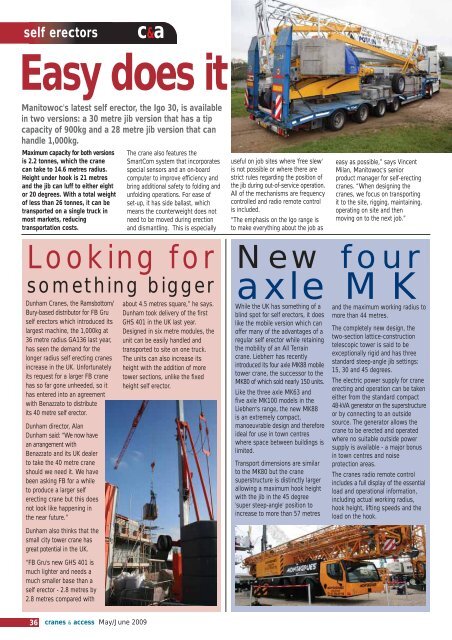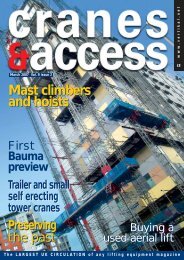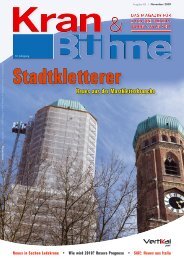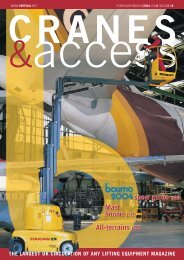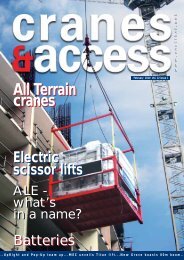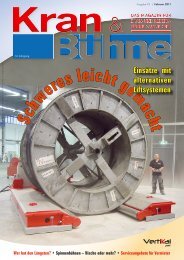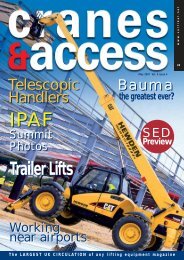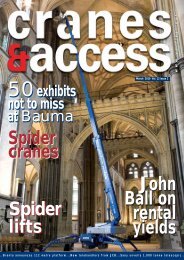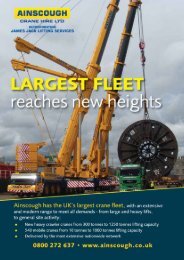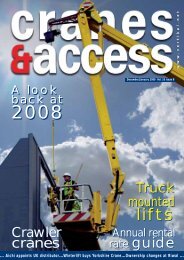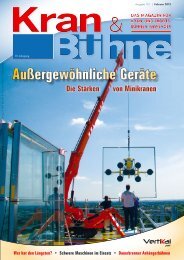Create successful ePaper yourself
Turn your PDF publications into a flip-book with our unique Google optimized e-Paper software.
self erectors c&a<br />
Easy does it<br />
Manitowoc's latest self erector, the Igo 30, is available<br />
in two versions: a 30 metre jib version that has a tip<br />
capacity of 900kg and a 28 metre jib version that can<br />
handle 1,000kg.<br />
Maximum capacity for both versions<br />
is 2.2 tonnes, which the crane<br />
can take to 14.6 metres radius.<br />
Height under hook is 21 metres<br />
and the jib can luff to either eight<br />
or 20 degrees. With a total weight<br />
of less than 26 tonnes, it can be<br />
transported on a single truck in<br />
most markets, reducing<br />
transportation costs.<br />
Dunham Cranes, the Ramsbottom/<br />
Bury-based distributor for FB Gru<br />
self erectors which introduced its<br />
largest machine, the 1,000kg at<br />
36 metre radius GA136 last year,<br />
has seen the demand for the<br />
longer radius self erecting cranes<br />
increase in the UK. Unfortunately<br />
its request for a larger FB crane<br />
has so far gone unheeded, so it<br />
has entered into an agreement<br />
with Benazzato to distribute<br />
its 40 metre self erector.<br />
Dunham director, Alan<br />
Dunham said: “We now have<br />
an arrangement with<br />
Benazzato and its UK dealer<br />
to take the 40 metre crane<br />
should we need it. We have<br />
been asking FB for a while<br />
to produce a larger self<br />
erecting crane but this does<br />
not look like happening in<br />
the near future.”<br />
Dunham also thinks that the<br />
small city tower crane has<br />
great potential in the UK.<br />
“FB Gru's new GHS 401 is<br />
much lighter and needs a<br />
much smaller base than a<br />
self erector - 2.8 metres by<br />
2.8 metres compared with<br />
36 cranes & access May/June 2009<br />
The crane also features the<br />
SmartCom system that incorporates<br />
special sensors and an on-board<br />
computer to improve efficiency and<br />
bring additional safety to folding and<br />
unfolding operations. For ease of<br />
set-up, it has side ballast, which<br />
means the counterweight does not<br />
need to be moved during erection<br />
and dismantling. This is especially<br />
Looking for<br />
something bigger<br />
about 4.5 metres square,” he says.<br />
Dunham took delivery of the first<br />
GHS 401 in the UK last year.<br />
Designed in six metre modules, the<br />
unit can be easily handled and<br />
transported to site on one truck.<br />
The units can also increase its<br />
height with the addition of more<br />
tower sections, unlike the fixed<br />
height self erector.<br />
useful on job sites where 'free slew'<br />
is not possible or where there are<br />
strict rules regarding the position of<br />
the jib during out-of-service operation.<br />
All of the mechanisms are frequency<br />
controlled and radio remote control<br />
is included.<br />
“The emphasis on the Igo range is<br />
to make everything about the job as<br />
easy as possible,” says Vincent<br />
Milan, Manitowoc's senior<br />
product manager for self-erecting<br />
cranes. “When designing the<br />
cranes, we focus on transporting<br />
it to the site, rigging, maintaining,<br />
operating on site and then<br />
moving on to the next job.”<br />
New four<br />
axle MK<br />
While the UK has something of a<br />
blind spot for self erectors, it does<br />
like the mobile version which can<br />
offer many of the advantages of a<br />
regular self erector while retaining<br />
the mobility of an All Terrain<br />
crane. Liebherr has recently<br />
introduced its four axle MK88 mobile<br />
tower crane, the successor to the<br />
MK80 of which sold nearly 150 units.<br />
Like the three axle MK63 and<br />
five axle MK100 models in the<br />
Liebherr's range, the new MK88<br />
is an extremely compact,<br />
manoeuvrable design and therefore<br />
ideal for use in town centres<br />
where space between buildings is<br />
limited.<br />
Transport dimensions are similar<br />
to the MK80 but the crane<br />
superstructure is distinctly larger<br />
allowing a maximum hook height<br />
with the jib in the 45 degree<br />
'super steep-angle' position to<br />
increase to more than 57 metres<br />
and the maximum working radius to<br />
more than 44 metres.<br />
The completely new design, the<br />
two-section lattice-construction<br />
telescopic tower is said to be<br />
exceptionally rigid and has three<br />
standard steep-angle jib settings:<br />
15, 30 and 45 degrees.<br />
The electric power supply for crane<br />
erecting and operation can be taken<br />
either from the standard compact<br />
48-kVA generator on the superstructure<br />
or by connecting to an outside<br />
source. The generator allows the<br />
crane to be erected and operated<br />
where no suitable outside power<br />
supply is available - a major bonus<br />
in town centres and noise<br />
protection areas.<br />
The cranes radio remote control<br />
includes a full display of the essential<br />
load and operational information,<br />
including actual working radius,<br />
hook height, lifting speeds and the<br />
load on the hook.


